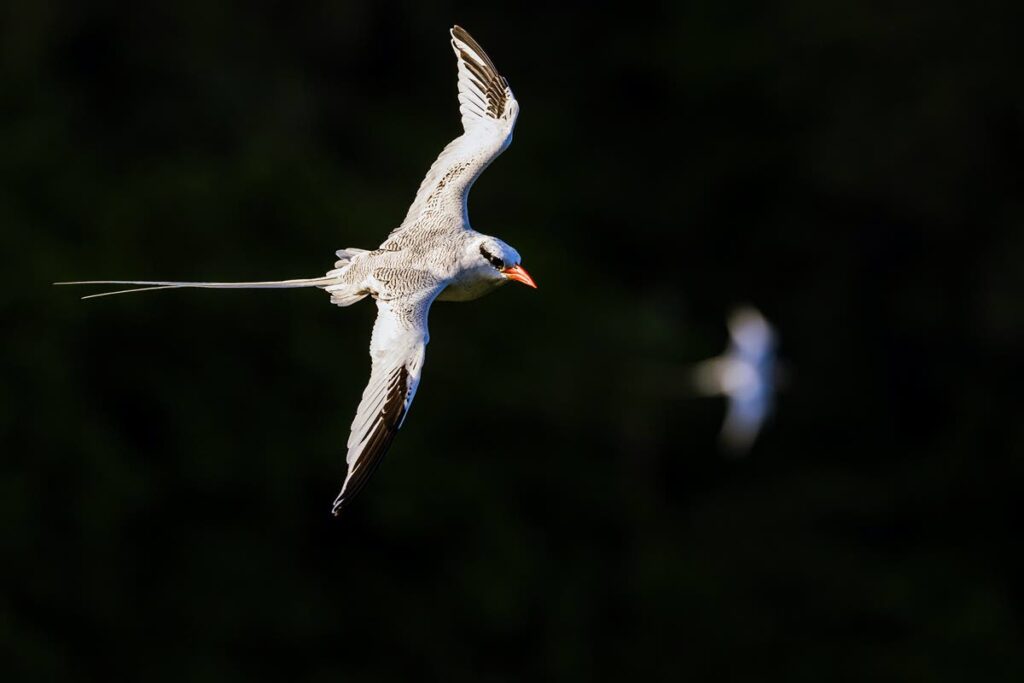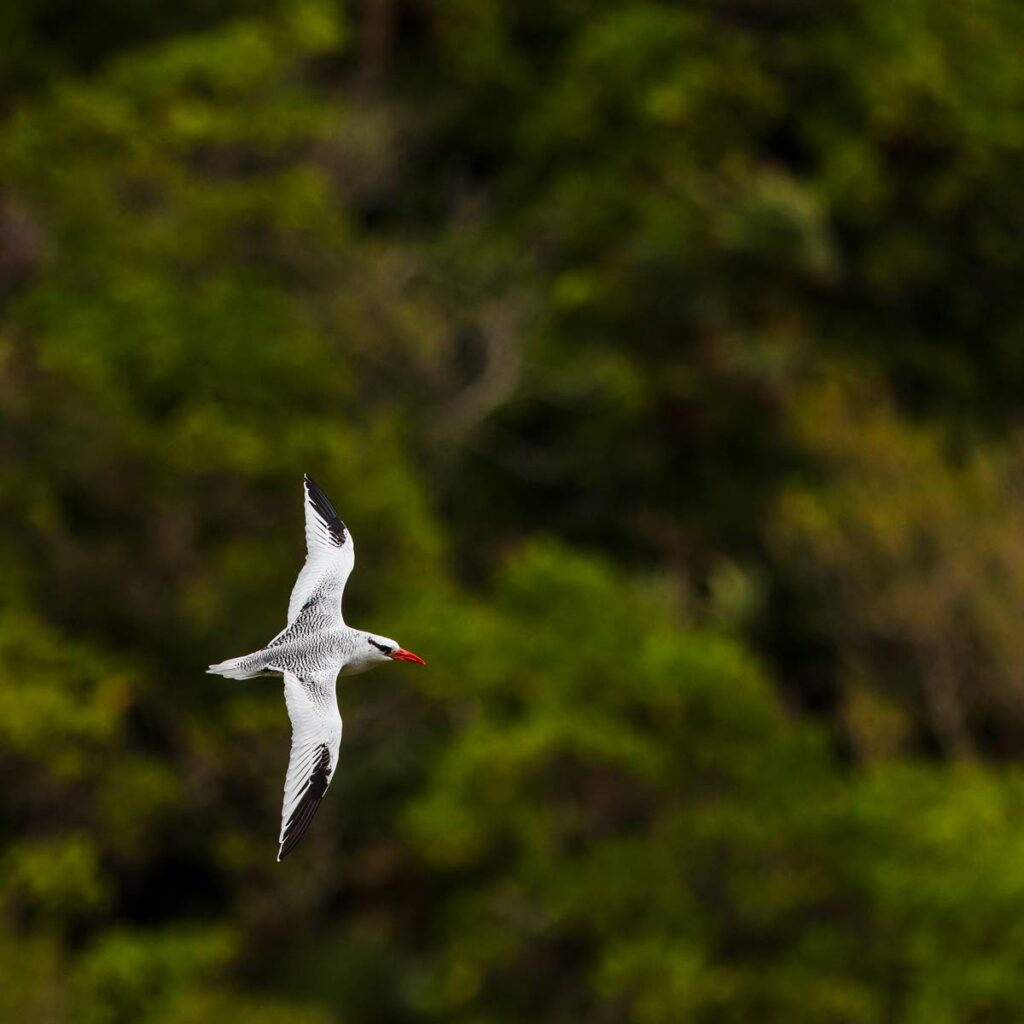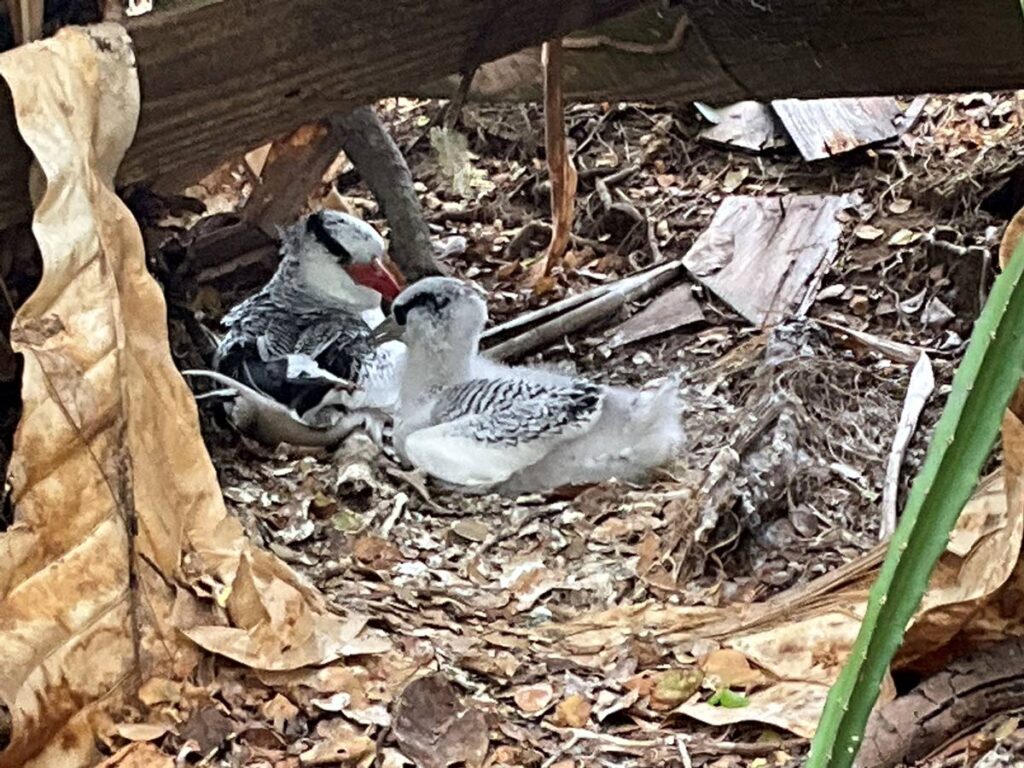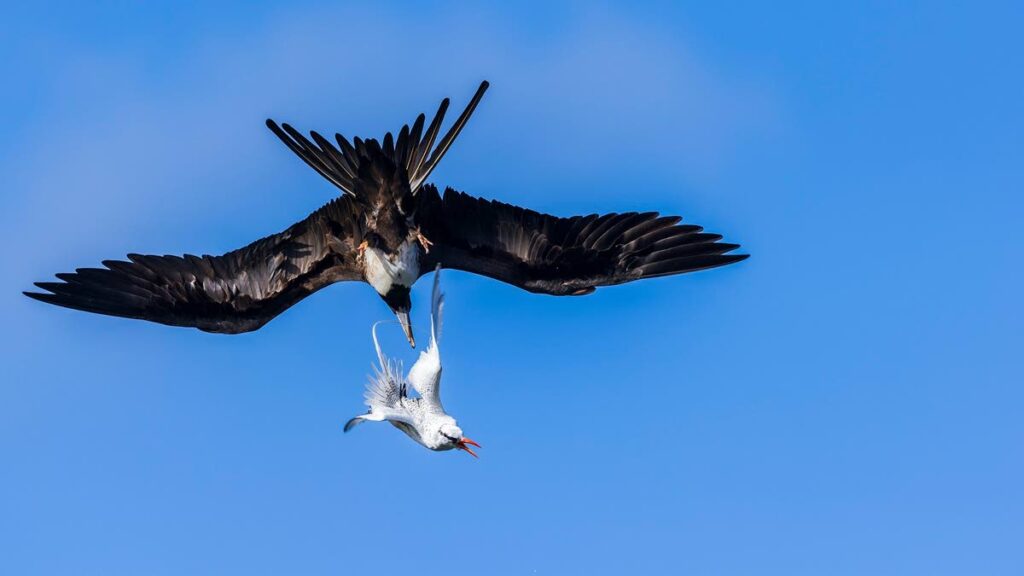Life on the edge of the Atlantic

Not just turtles spend their lives in the open sea returning to land only to nest. Some birds too live on the wing over water. Faraaz Abdool describes the life of the red-billed tropicbird which nests on Little Tobago.
It begins with the cracking of an egg, precariously placed in nothing more than a loosely scraped clearing on the precipitous slopes of Little Tobago. A ball of greyish fuzz emerges, a brand new red-billed tropicbird – an angel of the Atlantic. In the weeks before it develops the ability to fly, the young tropicbird enjoys a continuous delivery of fresh flying fish each day from both parents. Unaware of the trials and tribulations ahead, it grows quickly.
Young tropicbirds typically enter the world without a sibling. They aren’t alone, however, as red-billed tropicbirds arrive in their hundreds to breed on Little Tobago. Technically, tropicbirds are not colonial by nature – even while nesting – they can nest on their own or among others with equal comfort. It is the environment that dictates much of their movements and mannerisms. The geology, ecology, and location of Little Tobago combine to make an idyllic breeding site, attracting not only tropicbirds, but many other species of seabirds.
Our young red-billed tropicbird enjoys a charmed life. The mild climate and the lack of terrestrial predators on this small tropical islet mean that the chick can grow in peace. Little Tobago sits near the edge of the South American continental shelf, at the confluence of the Atlantic Ocean and Caribbean Sea. The proximity to deep water upwellings and boundary lines between major currents adds to the appeal of the island, as a steady and accessible food source is essential for being able to bring a hatchling to adulthood.

After approximately three months of being landlocked, the red-billed tropicbird begins to stretch its wings. Freshly sprouted flight feathers beg to hold the bird aloft – but to become airborne it must first get itself to an appropriate launch point. Tropicbirds are built for the open ocean, they are ill-equipped to manoeuvre through branches and over rocks. For those on the extreme edge of the cliff, they can simply spread their wings and allow the rising wind currents to lift them off the island. Tropicbirds nesting under the cover of Little Tobago’s dry forest must hop and stumble until they can get a view of the horizon.
Once a bird begins to fly, it leaves the nest and is considered to have fledged. Many of the birds we are familiar with – mockingbirds, thrushes, tanagers, hummingbirds, and so on – continue to be fed by parents until the young bird learns the ropes of adulthood. Once a tropicbird fledges, however, it is considered capable of sourcing its own meals!
Red-billed tropicbirds feed on a variety of small fish and squid. The population that breeds in the Caribbean is reported to subsist mainly on flying fish. Even though all four toes on tropicbird feet are webbed, they are mostly used for paddling around passively as opposed to other, stronger-legged seabirds such as boobies and shearwaters that are skilled in the arts of the submarine pursuit. Tropicbirds pick up fish that are on or very near to the surface, while they will dive from some height, they do not swim underwater. This modus operandi puts them in a very vulnerable position if small fish have no reason to be near the surface. The birds rely on larger marine predators – tuna, dolphins, and others – to force schools of smaller fish to the surface. As the smaller fish come under siege, they band closer and closer together, forming a “bait ball.” This catalyses a feeding frenzy from all quarters: the mass of small fish presses closer to the surface, with some species taking to the air on enlarged pectoral fins. For the tropicbirds, this is lunch served on a platter.

Fresh from its nest, the young red-billed tropicbird enters a steep learning curve as it begins a pelagic lifestyle. It must quickly learn the ways of the featureless ocean. As it matures, it roams freely across the tropical Atlantic. Much like where it hatched on Little Tobago, there are no predators on the open ocean. It is likely to spend a few years without ever coming within sight of land, obtaining all it needs from the sea.
Eventually the urge to procreate takes over. Having spent all its time either floating on or flying over the Atlantic, the young tropicbird begins to drift closer and closer to where it started. Tropicbirds aren’t as particular as some other seabirds that reuse the exact location each time, but those hatched on Little Tobago likely return to the island to raise their own broods.
Even though the tropicbird chick was nurtured on Little Tobago, life as an adult is decidedly different and considerably less straightforward. Once their egg hatches, the adults face daily challenges gathering fish to feed the waiting mouth. Overhead loom the W-shaped silhouettes of magnificent frigatebirds with other ideas.

Magnificent frigatebirds are much larger than red-billed tropicbirds and seem to lazily soar over the island, unaware of the activities below. Nothing could be further from the truth. Frigatebirds also eat fish and squid, but they lack the oil glands necessary to waterproof their feathers – so they cannot get wet. They therefore rely on food picked off the surface, or when the tropicbirds are nesting – kleptoparasitism. The ever-observant frigatebirds single out an incoming tropicbird and mount an attack. Approaching from behind with surprising speed, the frigatebird grabs the unsuspecting tropicbird by the tail and shakes it violently. If the tropicbird wants this harassment to stop, it must give up its bounty – fresh fish.
Experienced red-billed tropicbirds employ various techniques to evade the pirates. Some may travel in groups, others fly low over the surface of the ocean. Regardless of the onslaught, the tropicbirds are ultimately successful in fledging generations of chicks. The trials of life permeate all existence. Tropicbirds have more tricks learned from their pelagic life. The battles continue while the birds raise their chicks, and both species survive in nature’s balance.


Comments
"Life on the edge of the Atlantic"